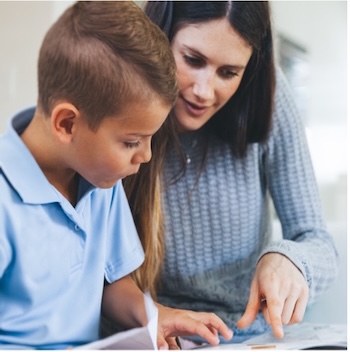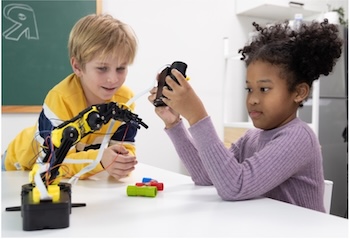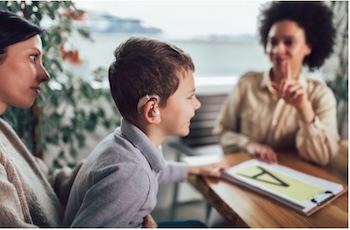Ohio PROMISE: Eliminating Inequities, Making Meaningful Inclusion a Reality for Each Child
Ohio PROMISE is about “making sure that each child gets to live their version of the American dream, whatever that dream is,” said Dr. Wendy Grove, currently serving in the dual roles of Director of the Office of Early Learning and School Readiness at the Ohio Department of Education and Workforce, and Senior Advisor for Research, Evaluation & Impact for the newly created Ohio Department of Children and Youth.

Trained as a medical sociologist, Grove’s career path has involved teaching students of all ages including undergraduate and medical students; coordinating professional development for birth to three programs, and later early intervention, early hearing and detection, and early maternal health and infant programs for the Ohio Department of Health; and overseeing early childhood programming for the Ohio Department of Education and Workforce (formerly the Ohio Department of Education).
The impetus for the creation of Ohio PROMISE began with a grant funded by the Early Childhood Technical Assistance Center in response to a proposal written by Grove. “The grant allowed us to take a deep dive into our state’s current state of affairs around early childhood inclusion. We looked at our policies and procedures, our standards for personnel, and our parent engagement and public awareness, and rated ourselves on how close we were on key elements. We had to be honest with ourselves about where we were as a state and, ultimately, came to the conclusion that we had a lot of work to do,” recalled Grove.
A State Leadership Team was established by Grove to guide the development of what would become Ohio PROMISE. “It was bringing together the expertise and passion of all the different committee members,” reflected Dr. Kathy Lawton, a long-time member who serves as the Director of Early Childhood Programs for the Franklin County Board of Developmental Disabilities. “The Committee as a whole is incredible and Wendy has such a gift for bringing initiatives across the finish line and compelling people to act,” she added.

So What’s Ohio PROMISE?
Ohio PROMISE – officially announced on October 16, 2023 by Governor DeWine and Ohio Department of Children and Youth Director Kara Wente – stands for Promoting Resources, Opportunities, and Meaningful Inclusion through Support and Education.

“What I love about Ohio PROMISE is that it addresses what we’ve known to be obstacles and challenges associated with four distinct areas: the professional, the program, the parent, and the needed support. Without addressing any one piece or part, our chances of success would have been diminished,” explained Grove.
The four inter-related components of Ohio PROMISE include a new provider credential, a new program designation, a new Center of Excellence, and a new scholarship pilot program. Each component is described next.
Component #1: Professional Early Childhood Inclusion Credential
Individuals earning the new credential have more knowledge, are more competent, and are more confident creating inclusive environments that improve experiences for children with disabilities and their families. The training and support available is open to anyone and everyone from individuals who are high school graduates to already licensed professionals.

“We started with the credential because we know that specialized training is an important component in early care and education for the quality of the caregiver, the educator, and the child, and for positive child outcomes,” Grove explained. Lawton agreed: “Ohio childcares and preschools are serving increasingly complex children. High quality early childhood education is especially important for these children, yet professionals have rarely been taught how to work successfully with children who require personalized strategies.”
Level 1 of the credential is about raising awareness. It’s available at no cost and on demand, and is accessible to all. “It is very basic but that’s because our purpose was to get the word out to as many people as possible. In its first two months of being available, there have been almost 1,800 people who have completed the training and earned the credential,” said Grove.
Levels 2 and 3 of the credential, each building on the previous level, will be released in 2024 and will move from a focus on the “whys” in Level 1 and 2 to a focus on the “how” (i.e., the implementation of best practices) at Level 3.
Component #2: Inclusive Child Care Program Designation
“One of the things we’re excited about is that the credential is required for one lead teacher and one administrator of any program seeking the program designation,” said Grove. This designation allows parents to identify which programs are staffed by educators that have earned the Professional Early Childhood Inclusion Credential using the state’s child care search tool, https://childcaresearch.ohio.gov.

Once a program receives the designation, it’s eligible for financial and other incentives. Within its first two months of existence, 780 programs received the designation. “It’s a work in progress; we set the bar at a reasonable introductory level. We’re hoping to add different levels of incentives to help programs with whatever stands in the way of having high-quality environments for our children with disabilities,” said Grove.
Grove credits Governor DeWine with challenging her and others to increase access to programs. “He asked us, ‘how come there aren’t places for these children to go? That’s what their parents are telling me,’” Grove recalled. “We know it’s not against the law to deny entry into privately owned childcare. And, it’s also not against the law to ‘soft expel’ or ask a family to leave because of challenging behaviors. So, we needed to reduce obstacles to support them in their knowledge and practice; which is component 3,” she added.
Component #3: Early Childhood Inclusion Center of Excellence
The Early Childhood Inclusion Center of Excellence, operated through OCALI, will (1) provide materials and equipment for child care professionals and families, (2) serve as a hub for and provide training and technical assistance to early childhood and education professionals, (3) coordinate a regional system staffed by four inclusion support specialists, and (4) collect data on requests received. More information can be found at https://cycsuite.org/ec-inclusion.

The Center of Excellence will work under the supervision of Dr. Laura Maddox, Director of OCALI’s Center for the Young Child. Inclusion support specialists are assigned to the northwest, northeast, southeast, and southwest quadrants of the state, and the Center will work with state support teams (SSTs), educational service centers (ESCs), and local education agencies (LEAs) to identify outstanding areas of need in the system related to training and/or resources and to improve communication and partnership efforts at the local and regional levels. The Center will provide presentations and training, individual consultation and technical assistance, practice-based coaching, assistance with cross-agency collaboration, and community and program capacity-building support.
The Center will also increase access for early childhood professionals and families to assistive technology and accessible educational materials. This support includes child-specific support, training giveaways, universal access kits, and grab and go sessions to build awareness of inclusionary early care practices.
Lawton remarked, “The Center of Excellence is groundbreaking! It is especially exciting that community teachers have the ability to receive direct coaching and support regarding how to include children. This is exactly what Ohio teachers and center Directors have been asking for.”
Component #4: Scholarship Program
The final component involves financial support for families. “So, if we’ve got people who are specialists in programs that have a designation and a family wants to attend, then what’s the last barrier? Often, it can be a financial one,” Grove explained.
The pilot scholarship program is specifically for children who are not eligible for publicly funded childcare and who are also at/below 200% of the federal poverty level. “That slice of the population rarely has access to the kind of funds that can go directly to paying for high-quality early care and education for their children,” added Grove.
Children who receive scholarship support must have identified and documented disabilities under the Individuals with Disabilities Education Act (IDEA) and must have an Individual Family Service Plan (IFSP) or an Individualized Education Plan (IEP). For more information on how to apply, visit https://childrenandyouth.ohio.gov/for-families.
Reducing Inequity through Passion, Leadership, and Systems Thinking
Ohio PROMISE is a four-part plan to change the system of early care and education on behalf of all children in the state. “We’ve got to do better; we have to expect it and support the professionals who are supporting the children. Our hope is that Ohio PROMISE will increase educator capacity to meet a wider range of student needs. If we don’t expect inclusion – full meaningful access and participation and support in children’s earliest years – when will we? We never will. And our history shows that, so we can and must do better,” said Grove.

“Through Ohio PROMISE, we’re investing in young children with disabilities. We are using proven and targeted strategies to make it possible for all Ohio preschools and childcares to support young children with disabilities,” said Lawton.
“Our promise to each child in Ohio and their families is that we will reduce the inequity that exists between our children of varying and differing abilities,” Grove added. Lawton stated, “Ohio PROMISE is not only a promise to our children, but also to our parents and teachers. Ohio PROMISE is what parents and professionals have been asking for and it’s the right thing to do. We need to include children with disabilities as early as possible in preschools and community childcares. We can only do this by supporting, educating, and empowering our teachers.”
“People get stressed and they get challenged when they’re told they need to include and work with a learner with complex needs. If we don’t provide them with any tools, it’s not going to work. They’re all our children and need to be welcomed into the classroom when their brain is malleable and when they’re in a formative stage of development,” added Lawton.
Foundational Supports.
Grove cites three foundational resoures that provide support to early childhood educators in educators in grounding their work in evidence-based practice. The first is the revised Early Learning and Development Standards, adopted by the State Board of Education in June 2022. “Ohio’s Early Learning and Development Standards guide educators in selecting and developing curriculum to provide appropriate, educationally beneficial opportunities for young children from infancy through the end of preschool.” (Ohio Department of Education, 2022, p. 6).

Grove describes the standards as “the foundation and cornerstone for everyone who is working with children from birth through kindergarten entry.” “I’m very proud of our team. The standards are no longer age-anchored and there are now multiple ways to demonstrate the skills that help educators support children across the continuum of a disability, support English learners, and children who typically may not have been able to demonstrate a skill because there was only one way to demonstrate it and they needed additional support,” she added.
Two additional supports, developed by the Ohio Center for Autism and Low Incidence (OCALI) with input from Grove include (1) no-cost training for educators and teams to improve the transition process for young children moving from Part C (early intervention) to Part B (preschool) services, and (2) the OLAC online module, Leadership for Early Childhood Care and Education.
In addition to these supports, Grove encourages districts and schools to include early childhood professionals on their collaborative leadership treams (i.e., district leadership teams, building leadership teams, teacher-based teams). “If they’re included, they will be, in my opinion, able to contribute at such an important level because they’re the ones that get to know the child first,” she said.

Looking Ahead
In considering the progress that has been and will undoubtedly continue to be made through Ohio PROMISE, Grove hopes for three major outcomes over the next five or so years.
First, she hopes that each child in Ohio has access to high-quality early care and education. Second, she hopes that meaningful inclusion becomes an expected practice for each child, not something that is afforded to only some children. “I think it’s important to say not only inclusion, but meaningful inclusion where children can fully participate and feel like they belong from the beginning,” said Grove.
Lastly, she hopes that the widespread benefits of early childhood inclusion for all children is universally understood. “We already know that early childhood education matters! We know that the research and accumulated knowledge already tell us its beneficial, not only for children with disabilities, but for all children. And we know that, based on Ohio data, where children start in their kindergarten readiness actually predicts, not just correlates, where they’ll be at third grade,” she said. “Children do enough in learning how to adapt to our system structures. We’re the adults; we have to learn how to meet them where they are, not the other way around.”
Will the thoughtful, comprehensive, and strategic activities being implemented through Ohio PROMISE be enough to realize these hopes and aspirations? Every aspect will be evaluated according to Grove and the data and feedback collected will be used to make improvements and/or course corrections in the services provided.
“You cannot launch a multi-faceted effort like this without intentional planning; it takes money and it takes people. But, I don’t want it to live or die by a champion. I want it to live or die by the data,” said Grove.
References
Buckeye Association of School Administrators (BASA) (2022). Ohio's leadership development framework (3rd ed.). https://ohioleadership.org/storage/ocali-ims-sites/ocali-ims-olac/documents/13073-OLAC-Book-2021-WEB.pdf
Ohio Department of Education and Ohio Department of Job & Family Services (2022). Early learning and development standards. https://education.ohio.gov/getattachment/Topics/Early-Learning/Early-Learning-Content-Standards/Early-Learning-and-Development-Standards.pdf.aspx?lang=en-US
For More Information
For more information about Ohio PROMISE, contact:
- Wendy Grove, PhD, Senior Advisor, Research, Evaluation & Impact, Ohio Department of Children and Youth, at Wendy.Grove@childrenandyouth.ohio.gov.
For more information about resources to support districts, contact:
- OLAC Director Mike Trego at trego@basa-ohio.org, or
- OLAC Consultants Jim Gay, PhD at jimgay@basa-ohio.org or Karel Oxley at Oxley@basa-ohio.org.